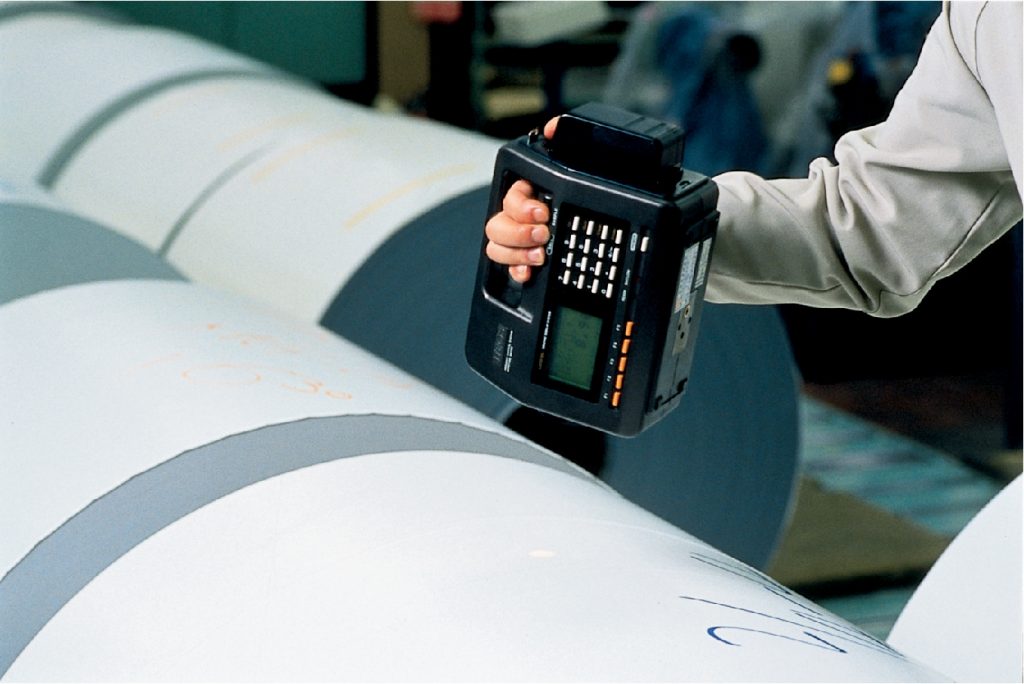
Products
Test & Measurement
Simplifying moisture measurement for optimal quality, efficiency
May 11, 2018 By P&PC staff
 Kett KJT130 paper measurement.
Kett KJT130 paper measurement. May 11, 2018 – Measuring and moisture content control can impact product quality, production throughput and processing efficiency in the pulp and paper industry, not to mention the purchase price of wood chips, pulp, converted paper products and shipping costs.
As paper is made from pulp wood fibres that are boiled, bleached, strained, flattened, dried into continuous webs, and then converted into various paper products, measuring and controlling moisture content is critical every step of the way. A pulp or paper product’s quality, drying efficiency, as well as transactions based on weight, can be adversely affected by improper moisture content.
Handheld devices are now available that allow even less-skilled personnel to take lab-quality moisture measurements. These “point-and-measure” options allow moisture readings to be quickly taken at any stage of the process, as well as at loading docks, on trucks, at suppliers, or in bins, vats or vessels. By simplifying the process, pulp and paper producers and converters can increase the quality of their products from wood chip receipt and pulping to end product conversion and distribution.
Although traditional laboratory and online based moisture measurement techniques are useful in the right settings, they have lacked the simplicity and flexibility required for frequent spot checks.
One common test is Loss on Drying, which measures the total material weight change after drying. However, such tests typically require a sample to be prepared and brought back to the lab. The test takes at least 15 minutes to several hours to perform, which is too slow when more immediate measurements are required. It also requires the sample to be altered or destroyed.
The other common test is a Karl Fischer (KF) test. This procedure calls for chemical reagents to be added to the sample to separate the water from the remaining product and is normally used on liquid samples. The water removed is then compared with the initial mass or volume. Samples are generally small, making the assumption that a large batch is homogenous. Also, since the chemical reagents need to be used, skilled personnel are required to determine the initial parameters, confirm that the system is properly calibrated and maintained and, at times, required to actually conduct the tests. Disposal of the reagents and waste can be subject to substantial documentation and costly handling.
As a result, secondary test methods have typically been used to deliver faster results. This type of test uses an indirect method and a single conversion to achieve accurate results. Secondary measurement techniques are routinely accepted as equal to the gold standard method. Examples are speedometers, common infrared and liquid thermometers and most pressure gauges. If there is a disadvantage, it is that the instrument must first be calibrated to ensure accurate results. In some cases, calibration could only be performed by trained staff familiar with the equipment.
In response, industry innovators have developed a simplified approach that allows even less-trained personnel to take portable, instant moisture reading spot checks of pulp and paper industry inputs, in-process conditions, or finished products as needed. This can be used for measuring wood chips and incoming fibre before the “value-add” of the mill begins. It can include checking pulp sheets before pulp mill processing, analyzing the web for wet streaks and uneven drying before or after dryer cans, inspecting incoming roll stock before conversion, and of course at end product quality checks.
The approach involves moisture meters that utilize Near-Infrared (NIR) light, a highly accurate, non-contact, secondary measurement method that can deliver immediate, laboratory quality moisture readings.
“NIR moisture meters allow very accurate instant measurement of solids, pastes, slurries, and liquids without contact or sample preparation, so there is no contamination in handheld and online models,” John Bogart, managing director of Kett USA, a manufacturer of a full range of moisture and organic composition analyzers, said. “Once the meter has been calibrated against the lab or production standard, the calibration is stored in the device so no calibration is required in the field. Measurements are fully traceable to the original measurement method.”
Unlike complex laboratory equipment, portable NIR equipment is designed for ease of use. For example, with Kett’s KJT130 Handheld Portable Instant Moisture Meter, the user simply points the instrument at the product and the moisture content is instantly shown on a digital display, with results accurate to .01 per cent in a 0-100 per cent measurement range.
For ease of use, the unit is operated via user friendly menu commands. The unit, which is the size of a camcorder, is designed for frequent spot checks wherever necessary, on both stationary and moving (process line) products. Moisture measurement data may be stored in the instrument, downloaded continuously, or manually recorded.
The same technology is also available for online/inline systems that allow instant, moisture measurement on pulp and paper production lines. Such continuous monitoring can help to eliminate costly batch waste, and provide superior data to optimize the process. Instant desktop options are available as well for settings where producers want to remove a sample, test it, and then replace it.
For more information, visit www.kett.com.
Print this page